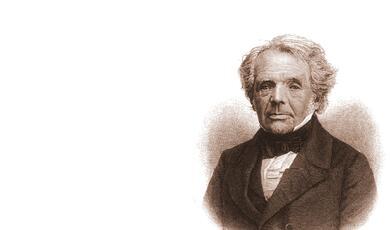The birth of heritage and the fabrication of history
Share
- Details
- Text
- Audio
- Downloads
- Extra Reading
This lecture will examine how heritage protection began and went on to shape out attitudes to our history and the past. Simon Thurley is Visiting Gresham Professor of the Built Environment.
Download Text
The birth of heritage and the fabrication of history
Dr Simon Thurley
It gives me great pleasure to deliver this, the first of four special Gresham Lectures as Visiting Professor of the Built Environment. In my first two lectures, tonight and on the 10 of December I intend to take a look at the politics of preservation in England over the last 150 years. The second two, early next year, I will be looking at London and the politics of its development as a capital.
This evening I want to be heretical. I want to ask whether the growth of the state protection of buildings, sites and monuments has distorted our view of the past. This is perhaps heresy from the man who is responsible for advising the government on just that issue. Yet it is an important question. History, of course, comes down to us through many different sources: through manuscripts, letters, diaries, the bureaucratic outpourings of civil servants, though paintings, artefacts and through oral tradition. Yet arguably the most present and powerful version of history that we enjoy is the historic environment: the landscape around us; buildings, streets, archaeological sites and even the remains on our shoreline. So it is important, if we are to understand our history, also to understand how what survives from our past is still with us.
An Englishman's home is his castle. This cliché is strangely true and perhaps helps explain why this country, which has an obsession with the past, was slow to introduce state protection for historic buildings and monuments. The first building in Europe to be protected by law was probably the Coliseum in Rome. In the eighteenth century Pope Benedict XIV declared it sacred to the Passion of Christ because of the early Christian martyrs killed in it. A more scientific system of protection was introduced into the German state of Hesse in 1818. Louis X of Hesse ordered the compilation of lists, surveys and records of historic buildings in order to preserve them and, most radically, a system of permissions for alteration. The French had created a state service for the protection of monuments by 1837. In comparison the first act in England was not until 1882 and that was a poor thing in comparison to most of the rest of Europe.
Yet after a hesitant start today we have one of the most comprehensive and, I would suggest, sophisticated systems for heritage protection in Europe. My purpose this evening is twofold. First to ask how did this system come about? And then secondly, and more importantly, what effect does a state run system of protection have on our view of English history?
In 1873 Sir John Lubbock, Liberal MP for Maidstone, started his 10-year campaign to give legal protection to our built heritage. Lubbock, the heir to a banking fortune, had been taught as a boy by his father's friend and neighbour, Charles Darwin. From his Down House tutorials Lubbock developed a lifelong fascination with the idea that progress and natural selection could be applied to a wide range of disciplines, including archaeology.
Lubbock's tenacity (he introduced a bill every year from 1873 to 1879) finally prevailed over a reluctant parliament and, in 1882, the Ancient Monuments Protection Act was passed. This was the first piece of state legislation to protect man made structures in England. It was passed by a Liberal government and had been opposed tooth and nail by the Tories - the defenders of private property. The Act established the principle that the state, in the form of the Commissioners of the Board of Public Works, could take into their care any of an agreed list or schedule of what were called 'ancient monuments'. The schedule attached to the bill listed 68 sites.
The composition of the list was determined by two factors: The first was a practical one - as none of the monuments had any modern function and all required little or no maintenance, Lubbock was able to convince both the Board of Works and private owners that transferring them would be cheap and easy. The second factor was a more personal one Lubbock was a prehistorian and so the sites scheduled were all prehistoric - mainly burial mounds and stone circles. An editorial published in The Times in 1882 noted that the Act, in its current form, would be of limited interest to the wider public, noting 'England will not go mad yet on clay funerary urns, flint heads and scrapers.' But Lubbock's enthusiasm was undimmed. When he was eventually made a peer he took the title Baron Avebury, causing one of his friends to ask whether it would be followed by his promotion to 'Viscount Stonehenge'.
The Act passed, General Pitt Rivers, the father of modern archaeology, was made first Inspector of Ancient Monuments and the transfer of sites from the schedule into public ownership began. Pitt Rivers held the post of Chief Inspector until his death in 1900, and by 1890 had seen all 63 monuments pass into state care.
In 1900 mounting concern with the state of various medieval buildings, notably the Eleanor Crosses, led to the passage of another measure, the Ancient Monuments Protection Act. This saw the definition of sites which could be taken into state care broadened, to 'any structure... of historical or architectural interest or any remains thereof'. There were two exclusions: churches and occupied buildings. This act opened the way for a whole category of monuments hitherto untouched to be taken into state care. Of these by far the most important were the monasteries dissolved at the Reformation and the castles slighted during the civil war.
A third act of parliament in 1913 put the icing on the cake. This act was stimulated by the case of Tattershall Castle, a magnificent fifteenth century brick keep built for Ralph Lord Cromwell in Lincolnshire. It was bought by a consortium of American businessmen who, in 1911, took out the fireplaces and packaged them ready to sell in America. The castle it self might have been pulled down but was bought, in the nick of time, by Lord Curzon. The Fireplaces were found at Tilbury Docks waiting to be loaded onto a ship. They were returned to the castle in triumph draped, coffin like, in a union jack. The dramatic rescue of Tattershall contributed to the act of 1913 which, after a hard fought debate, introduced a complex and cumbersome system for issuing a preservation order on a building at risk of demolition by a private owner. Each order would need an act of parliament to confirm it, so it was hardly an easy to use power, but it established the principle that some buildings in private ownership might, if they were important enough, warrant the intervention of the state to save them.
Pitt Rivers was succeeded by a new Inspector of Ancient Monuments Charles Reed Peers. It was Peers who had supported Lord Curzon in getting the 1913 act passed and who now had these new powers at his fingertips. Unlike Lubbock and Pitt Rivers, Peers was not a prehistorian or even an archaeologist, but was an architect - but an architect with impeccable historical credentials. He had been Architectural Editor of the Victoria Country History, editor of the Architectural Journal and was Secretary of the Society of Antiquaries.
Peers immediately set to work; he was operating in a different climate by the 1910s, and unlike Pitt Rivers was given proper resources to carry out his job. These came, most importantly, in the form of funds to appoint a specialist works division for the repair and maintenance of the sites, which was swiftly set up under the auspices of another Ministry of Works architect, Frank Baines. Between them Peers and Baines set about taking a huge number of historic buildings into care and instituting for the first time, a consistent regime for their treatment.
Now, while the debate about how historic buildings ought to be treated had raged during the 19th century, it was, for the most part, a debate between people whose ability to actually do anything was limited. The writer and critic John Ruskin, for instance, had lamented his own inability to have any real effect on buildings. Peers and Baines were in an entirely different position. The greatest medieval ruins of the country were literally pouring into the Office of Works and the two men had to decide in a very practical way what to do with them.
Peers was a methodical man, keen on establishing and pursuing agreed procedures. In his annual report to the Commissioners, he set out the measures which he intended to adopt to the sites which came into his care. What the report did not say is that his approach was also to apply a very rigid intellectual framework to the sites with the most unfortunate consequences. I will come on to this point in a minute, but first let's look Peers's philosophy. He saw uninhabited monuments as structures where 'the story of the building is definitely at an end' therefore the aim must be 'to preserve, with as little change as possible, what the lapse of Time has spared'. In other words, he said, 'repair and not restoration is the essence of the matter'.
But repair was an aesthetic as well as a technical activity. For Peers the charm and visual appeal of the buildings was not in their tumble-down, ivy strewn decay, but in what lay beneath; in his words 'What remains must be set off to the best advantage, if only for the mere pleasure of so doing and for the revelation of the beauties long hidden in their own ruins.'
Rievaulx, the first and greatest Cisterian foundation in northern England came into guardianship in 1917. Peers directed the full force of his philosophy to the ruins. A vast quantity of soil was cleared, sometimes as much as 16 foot deep, as were various post medieval structures, trees and other elements. A great programme of repair was undertaken, so the south side of the choir, for instance, where masonry was precariously overhanging, was secured with great longitudinal ties anchored at the bases of the vaults. Unsteady piers were taken apart, the cores filled with reinforced concrete, and then carefully rebuilt back to the form in which the Ministry had found them. Great care was taken in the course of this to ensure in the end result no trace of the intervention could be seen, so, as Baines proudly noted in 1922, 'in the twelve months which have transpired since the completion of the work, no trace of what has been undertaken is observable'. Work done and turf laid, the site was given the appearance which it still retains today.
The speed with which sites were put into state guardianship, and then given the Baines and Peers makeover was remarkable. In 1910 there were 89 properties in care and the numbers grew steeply in the following years, in 1913 alone 22 more monuments were added to the list, of which almost all were ruined abbeys and castles; and by Peers's death in 1952 400 sites in Britain were in the care of the state.
But for many of these monuments the Ministry of Works treatment was fundamentally distorting, because for Peers and Baines the monuments in their care were essentially products of the Middle Ages or earlier. Their mission was to reveal as much as still remained to be shown of the fabric of the pre-Reformation period; in Baines's own words, his job was 'to sink his individuality to the uttermost and merely to throw up the distinctive character and individuality of the medieval constructor'.
Post-medieval uses and additions were looked on unfavourably and at abbeys like Rievaulx what we would now consider an integral part of the history of the site, cottages, hostelries and farmbuildings, were thought of as 'accretions' and removed. Peers and his colleagues showed little anxiety at such 'clearances', safe in the knowledge that their concern was to reveal the beauty and truth that lay in the work of the 'medieval constructor'. Here is a photograph of the walls of Conway Castle in Wales. Against them are cottages dating from the eighteenth and nineteenth century. These particular buildings were demolished in the 1970s, but even earlier buildings were swept away in the 1950s. These later structures were perceived as having lesser importance than the medieval walls which were revealed by their demolition.
This approach partly sprung from a belief that almost all sites had one fundamentally defining period, and that the Ministry's job was to uncover and decode what remained from that time no matter what had to be demolished to allow that. This work of rationalisation and categorisation led to an archaeological philosophy that saw Castles and abbeys, built to a standard plan where each site could be interpreted and displayed in relation to that plan. Take Lindesfarne Priory as an example. Here we have a seminally important ruin, not only in architectural and archaeological terms but in the history of Christianity in Britain. In the early twentieth century the ministry interpreted the Priory as having a classic monastic layout rather than being much more closely based on a secular great house. The consequence of this was that to explain the site it was labelled up with signs on the lawns and on the ruins showing where the parts of the complex would have been. A sign saying chapter house was placed in the undercroft of a domestic lodging range and the great hall with its central hearth was identified at the monastic refectory. The determination to show the building as a standardised monastery made everyone blind to what the ruins were obviously showing.
This belief in a straightforward, standardised world where buildings were of a single phase was expressed in a wonderful and insightful series of ministry of works guidebooks - the blue guides, still useful today. These guides ignored any finds that may have been recovered during the clearance of the site, and concentrated on the core buildings rather than a wider context; many of the guardianship deeds - the legal documents setting out the area of land under the care of the ministry of works show boundaries drawn only three feet away from the monument. In dozens of cases the Ministry took only part of the site into guardianship leaving many parts that were built or embellished in the early-modern period quite separate from their earlier phases. In extreme cases the later buildings were simply demolished as unimportant. As a result many sites, Buildwas Abbey at first glance appear to be entirely medieval complexes, but on closer inspection it becomes clear that the parts of the site developed and re-built in the sixteenth and seventeenth century are still standing as private houses but dimly glimpsed the other side of the boundary fence.
At other sites such as Gloucester Blackfriars, an important Monastic house converted into a mansion after the Reformation later phases were simply demolished. The splendid sixteenth and seventeenth century interiors were removed in their entirety to expose what remains of the monastic church and scriptorium. What was left was a vast open scarred space, virtually meaningless in historical terms, not the crossing of the priory church, not the hall of the post reformation house, but an upstanding archaeological site.
Now I don't mean to give the impression that somehow the Ministry of Works turned bad in the mid 20th century. As a historian one always must be careful not to patronise the past. But my point is that the buildings and monuments that had undoubtedly been saved by Lubbock, Peers and their colleagues were moulded and defined by an approach to medieval history that was fundamentally distorting. But more importantly than that, the buildings they chose to save were not selected in any scientific manner. They were those which Peers and his colleagues found interesting and important. In fact if you were to plot onto a map the monuments that were taken into state care between 1882 and 1947 you would see that they were typologically and geographically a very partial selection. In fact sometimes you can tell that an Inspector was in the area and recommended a group of sites to go into guardianship, almost on a whim. Here is a bit of the English Heritage handbook for Dorset (The Office of Works sites simply became EH ones in 1983) - you will see this little isolated group of sites, no more or less important than many in the county, but nonetheless taken into care as a group. Clearly no inspectors went to the west of the county and no-one visited north Devon!
The work of the early inspectors was not academic but the product of the strong antiquarian tradition and of course it was this that was channelled into the creation of the first ancient monuments act. But in actuality before the 1950s passionate individuals did much more than the state to protect old buildings. It is, of course, a fallacy to imagine that before the 1880s when the state enshrined it in legislation people were not interested in the protection of old places, old buildings and landscapes. Queen Elizabeth I acted to stop protestant iconoclasts defacing 'monuments of antiquity' in 1560; Cromwell's republican government could not bring itself to demolish Hampton Court as it was an ancient part of England's history. The architect and playwright Sir John Vanbrugh pleaded for the preservation of the medieval remains of Woodstock palace in 1709. The owners of great estates made choices that deliberately preserved old buildings.
Take the Dukes of Devonshire for instance. During the sixteenth century they had two houses Chatsworth and Hardwick. In the 1690s Chatsworth was rebuilt as their glittering principal seat, leaving Elizabethan Hardwick old fashioned and neglected. Yet the house survived and is with us today. Its survival was due to the fact that it was admired as a historical curiosity, a survival from a previous age: as early as 1700 people were visiting it as a sort of Elizabethan theme park. In the nineteenth century this ancientness was being re-emphasised by rearranging the furniture, tapestries and pictures to give it an air of even greater venerability. For the Devonshires this ancient house represented their ancestry, the antiquity of their line, their claim to be one of England's ancient families. It was an expensive job keeping up a second great house - so it must have meant a great deal to them.
This fascination with what we would now call heritage had some very unfortunate consequences encapsulated perhaps by the work of the brilliant and maverick architect James Wyatt who between 1770 and 1813 restored many of our greatest cathedrals. His clearance of medieval screens, replacement of windows, doors and stained glass in the name of restoration and improvement gained him the nickname, in some circles, of 'Wyatt the destroyer'. Here you see engravings of Durham Cathedral as it was in 1780 and as proposed by Wyatt. Bits were to be added and more worryingly taken away. The chapter house was demolished before the Society of Antiquaries could stop him. But most of the rest of the cathedral was saved.
While the work of Victorian Restorers upset people what really changed people's attitudes was the industrial revolution. An event of such force that it seemed to many that the gentlemanly acts of antiquarian admiration that had hitherto protected ancient buildings and monuments were now powerless. A house like Hardwick was now surrounded by coal mines and coke works and acidic smog swirled round its Elizabethan turrets. The railway, mass housing for factory workers, docks, mines, quarries all seemed to threaten what it was that individuals could do.
The work of Victorian restorers compounded by the effects of the industrial revolution led directly to the foundation by William Morris of the Society for the Preservation of Ancient Buildings (the SPAB). Morris had been won over by the experience of driving past Burford Church and seeing chunks of medieval work being demolished in preparation for restoration. In 1878 the society launched its manifesto to protect ancient buildings from destructive restoration. They were the first conservation pressure group and with a clear message became an incredibly important and influential force in the development of heritage protection.
The other voluntary body to be formed at this period was the National Trust, in 1895. Although today perhaps most associated with country houses it was, in its early days more concerned with open spaces. In 1907 an act of parliament enabled the Trust to take on land inalienably, and thus protect it, in the current NT slogan 'forever, for everyone'. But what was really interesting was the change in tack adopted by the Trust in the first fifty years of its existence. Estate or death duty which had been hugely increased by Lloyd George in 1910 started to bite hard in the 20s and 30s. It seemed as if hundreds of country houses might be sold and demolished as a result. The Trust started a process of acquiring them. In 1934 Philip the 11 Marquis of Lothian addressed the National Trust's AGM setting out how he believed the Trust could save England's country houses from crippling death duties by getting the state to accept the estates in lieu of the tax and pass them to the Trust. An act was passed in 1937 which allowed this to happen and Blickling Hall in Norfolk, Lothian's own house, became the first NT country house in 1940.
What all this demonstrates is that though there was legislation in place by the 1880s the choices about which buildings and monuments were saved before the Second World War were rarely made by the government. It was private individuals who decided what to keep and what to demolish. Private societies 'we would call them NGOs, who lobbied for buildings to be preserved. Private charities who acted to save classes of buildings, like country houses that were threatened. These choices which, in as much as they were uncoordinated, disconnected, not part of any programme, produced a random preservation of buildings, continues to have an impact on how we perceive history today. The predominance of ruined monuments in the care of English Heritage and of country houses in the care of the National Trust are the result of the enthusiasms of people at the time. They could have chosen differently, and as a result we might have seen our history differently.
I'll give you one simple example. The Abbeys that were taken into state care, and that were restored by Charles Peers, were extensively photographed by the Office of Works. In the days before photography was cheap - and digital- people used the stock photos from the Office of Works photo libraries rather than seeking out examples of their own. Thus almost any book you read about monasteries written before about 1985 are almost exclusively illustrated by examples from the Ministry of Works files which were, as we have seen, in themselves a partial and misleading selection. Thus the way we read history has been influenced by what was chosen to save.
The acts of 1882, 1900, and 1913 that I have described only protected places and structures that were uninhabited. By 1931 there were 250 structures in state guardianship and 3,000 ancient monuments scheduled. The big change to preservation law came in 1932 in the Town and Country Planning act. The act introduced the principle that it was possible to protect a building that was inhabited (other than a church). Now, this wasn't easy to do as a local authority had to get a preservation order signed off by a minister, and the owner could appeal against the decision. But it wasn't the bureaucracy that made it a rarely used power it was the fact that the act made provision for compensation to the owner to compensate him for any inconvenience or loss of value. The Labour party endorsed the bill and its approach. The Tories were appalled. Sir Derek Walker-Smith stood up in the house 'this is just the sort of measure a socialist government would introduce. An enormous amount of power and control over the rights of property are invested in local authority and government departments'. He need not have worried in the years between 1932 and 1947 only a score or so orders were made.
But the overwhelming problem with the 1932 act from the perspective of the conservationist is that it did not make clear to local authorities what sort of buildings might be protected. Earlier on I suggested that the process of preservation before the Second World War was random, quirky, personal and not at all scientific. But that was, perhaps, not government's intention as the foundations of a more scientific approach were laid as early as 1908 with the foundation of the Royal Commission on Ancient and Historical Monuments and Constructions of England which was required to make an inventory of all the important buildings and monuments in England and recommend which should be protected for the future. The Commission was a great invention and produced a series of volumes, the first of which was published in 1910. Many people here may have had cause to refer to these important books. But the problem was the ambition of the project. It moved at snails pace: 50 years after it was founded only 20% of the country had been covered.
During the passing of the 1932 act the issue of a proper scientific method was raised again. Viscount Cranborne complained 'one of the chief failings of local authorities is a complete lack of artistic sensibility' he proposed that ministers have an expert committee that draw up a list of what should be preserved. 'There is no lack of experts in this country - innumerable people who have not very much to do, and plenty of taste, who would be able to do this work very well' in fact he argued 'all they would have to do, would be to take a large scale ordinance survey map and mark the buildings which ought to be preserved, there would not be a day's work in it!'.
All these attempts at putting preservation onto a scientific basis failed. The truth was that there was simply not enough political support for preservation. The Marquis of Hartington, during the debate on the 1932 act, said 'these buildings have been preserved to us not by acts of parliament but by the loving care of generations of free Englishmen who did not know who the minister of health was and who also did not know in many cases what a district council was'. Quite right. That was exactly how buildings had been preserved in the past, but was this good enough for the future?
Trotsky observed, what is in my opinion, one of the most important historical truths which is that 'war is the locomotive of history'. So it was in the scientific compilation of buildings of architectural and historic merit. As the London Blitz reigned it was realised that there needed to be some guidance as to which damaged buildings should be carefully repaired and which could be simply be demolished. So a panel of 300 architects was set up to inspect damaged buildings and create lists of those worthy of saving. The London list was the most professional and systematic, regional lists were much more hit-and-miss. Nevertheless these lists established the principle that it was going to be necessary, in the process of post-war reconstruction, to know a lot more about which buildings and places were of historical value.
It was as part of the 1944 Town and Country Planning act that proposals were finally accepted for a proper systematic basis for preservation. It was agreed that an expert committee be formed to supervise the compilation of a comprehensive list of buildings of sufficient merit to be worthy of preservation. This Advisory Committee on Listing had working for them a band of fourteen Temporary Inspectors. They were given a copy of this document Instructions to Investigators. This set out the criteria for choosing the buildings and assigning them a grade of importance either I II III or IV. So Ladies and gentlemen the first building in England to be listed (as opposed to scheduled) was Gosfeild Hall Essex on 1 August 1946. From that moment onwards the process of listing went ahead. The list was only finally completed in 1970 with just over 86,000 buildings.
But there were still two schools of thought. The first was represented by the poet laureate, architectural enthusiast and the most flamboyant conservationist of the immediate post-war years - John Betjeman. Betjeman has recently gained a statue in his most famous cause, St. Pancras Station. But he was a great advocate of the personal, amateur, gentlemanly process of preservation which the Office of Works and the National Trust had pioneered before the war. He was not that interested in scientific categorisation. His approach was tweed suits, pipes and country pubs.
On the other side was the brilliant German émigré Nicholas Pevsner, the founder of the Buildings of England series of architectural guides, now simply known as Pevsners. Pevsner was an art historian working at the Courtauld Institute and he set out to catalogue all the important buildings in England in a series of county volumes the first of which was published in 1951. There were 46 volumes in the end, the last one, Staffordshire was published in 1974. He was representative of the systematic methods of buildings categorisation that rapidly developed after the 1944 act.
There was no love lost between the two. To Pevsner Betjeman was an amateur, poet, TV personality and funny man. Meanwhile Betjeman said of Pevsner 'the introduction of professionalism into such subjects as literature, architecture and art too often turns enjoyment into ashes'. Their animosity broke out into open warfare in 1952 with insults traded in the pages of the TLS and other literary journals. Eventually the whole thing was satirised in Punch as a debate, in rhyme between the poet (Betjeman) and the pedant (Pevsner).
POET: A poet part Victorian
Part topographer that's me
(who was it tipped you Norman Shaw
In Nineteen thirty three).
Of gas-lit halls and old Canals
I reverently sing
But when big-chief-I-spy comes round
I curse like anything
PEDANT: A crafty art historian
Of continental fame
I'll creep up on this amateur and stop his little game!
With transatlantic thoroughness
I'll note down all he's missed
Each British brick from norm. to vic.
You'll find upon my list
Well, in the end the Pevsnarians won. In 1981, recognising the inadequacy of the original lists, Michael Heseltine set up a new survey of the entire country. At first he intended the survey to be finished within a decade, but then it was decided to accelerate the work and finish it in two years. 80 fieldworkers were recruited and sent out to look at every existing listed building and then to consider proposals for new listing from Local authorities. Although a huge amount was achieved and many buildings not considered before were added to the list (especially 18th and 19th century urban buildings) the process, though systematic, was not scientific. And so out of this came a new way of doing things.
This was called Thematic Listing. This was a truly methodical process looking at, for instance, all the non-conformist chapels in the whole of Cornwall. In this case inspectors were sent to every chapel to measure its quality against strictly formulated criteria. In April 1999 the new list for Cornish chapels was announced, cleaned up, rationalised and now truly representative. 28 chapels had been taken off the original list and thirteen new ones added. Finally scientific listing had come of age. The Tweed-wearers would have turned in their graves, Pevsner would have smiled contentedly.
So, what can I say in conclusion? Well, we have covered four periods tonight.
The first when preservation of monuments was solely in the hands of the owners. Then as a result of the destructive effects of Victorian restorers and of the Industrial Revolution a reluctant government introduced basic protection. This was not completely random but was determined by a tiny number of people with specialised and rather quirky interests and tastes.
In the third period the state was given powers to list buildings and control alterations to them. The first listings were systematic but not scientific, but by the late 1980s list compilation was done on a scientific basis reviewing entire types of building or whole geographical areas to make sure that the very best and most important examples were chosen.
In this my fourth period History was being made by bureaucrats. By people who had studied long and hard at the Courtauld Institute, who had degrees in art history. Preservation was no longer by random chance it was by state sponsored design. The history that future generations will see will have been carefully sieved and selected by experts not handed down randomly by chance.
Does all this sound too calculating? Perhaps. One's heart tends to lie with Betjeman but ones head with Pevsner. To appropriate Sellar and Yeatman's characterisation of roundheads and cavaliers Betjeman was wrong but romantic; Pevsner was right but revolting.
Obviously if we constrain people's property rights it must be done on more than a whim. If we are to affect the way our country looks in fifty or a hundred years time, we must have thought out our choices carefully. This is what the listing system set out to do by the 1980s and to a large extent it was successful in sorting out the important from the interesting and protecting it for the future. But by the 1990s other things started to change and people started to ask whether the system invented in 1944 was really serving us well fifty years later.
In my second lecture I will be looking at the politics of preservation since 1997. I will be taking up the story of protection where I have left off today, I will be suggesting that by the 1990s much of what I have described this evening was beginning to look very shaky. The world was changing rapidly and reform was in the air. It took a hundred years to devise a sensible and defensible system of heritage protection; but now we had it, perhaps we wanted something else.
I hope you will join me on December 10th to hear more.
© Dr Simon Thurley, 22 October 2009
This event was on Thu, 22 Oct 2009
Support Gresham
Gresham College has offered an outstanding education to the public free of charge for over 400 years. Today, Gresham College plays an important role in fostering a love of learning and a greater understanding of ourselves and the world around us. Your donation will help to widen our reach and to broaden our audience, allowing more people to benefit from a high-quality education from some of the brightest minds.


 Login
Login







